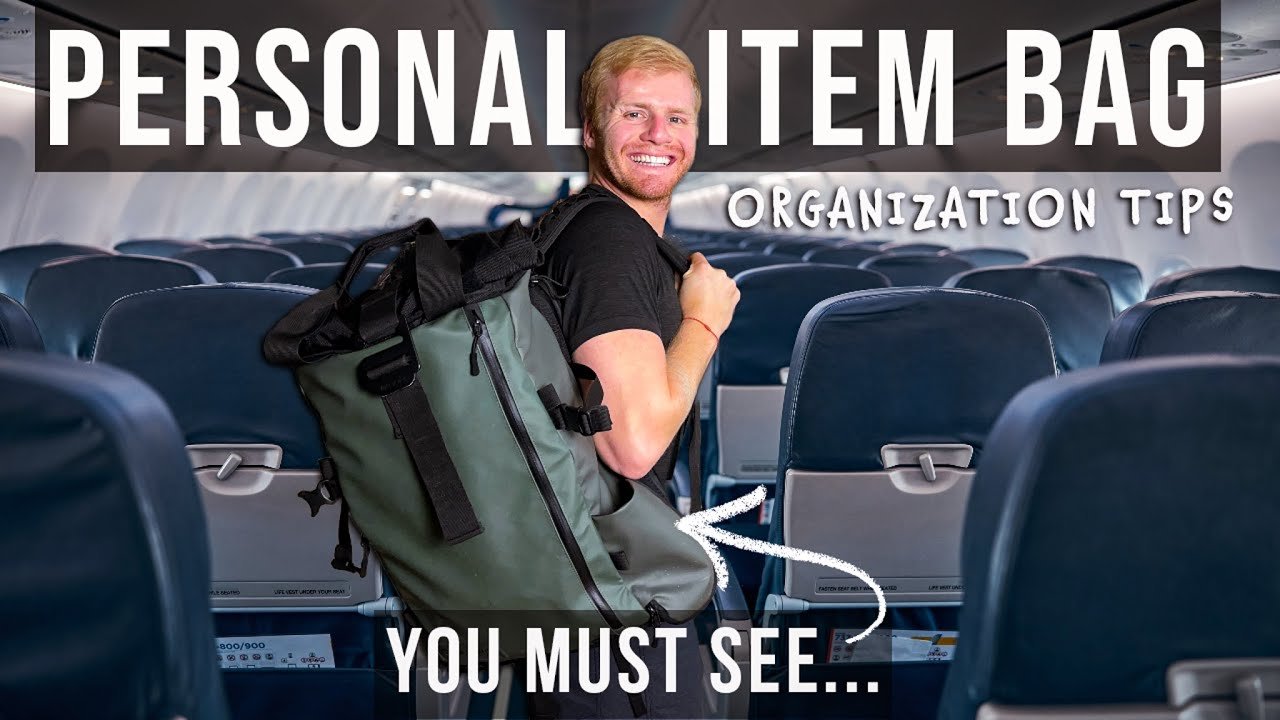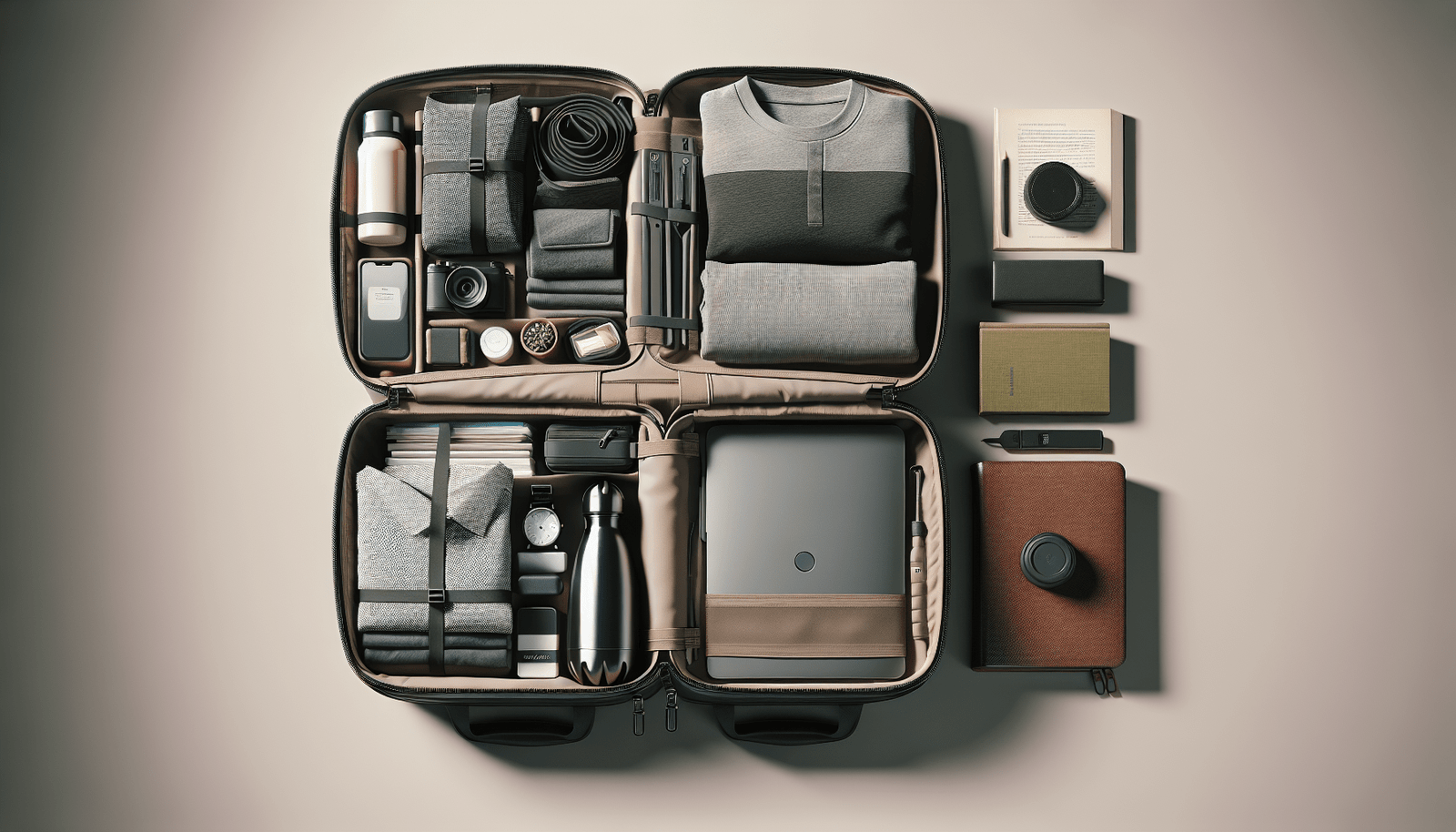Travelling light and staying organized can make your journey a whole lot smoother and more enjoyable. In “Strategies to Pack a Personal Item Carry-On Efficiently,” you’ll discover practical tips to maximize your personal item space, ensuring you have everything you need without the hassle. This guide focuses on avoiding common packing mistakes while providing a seamless security and in-flight experience.
From valuable items to in-flight essentials, each category will be covered with detailed advice on how to pack efficiently. Plus, you’ll gain insights on useful products and strategies to make your travels stress-free. Stick around to learn how a well-organized personal item can transform your travel routine, making it both efficient and enjoyable.

This image is property of i.ytimg.com.
Choosing the Perfect Bag
Choosing the right bag for your travels can make a significant difference in your overall experience. Here, we’ll dive into the factors you should consider to ensure you’re packing smartly and efficiently.
Optimal Bag Size – 15-25L for Efficiency
When it comes to selecting the perfect personal item bag, size matters. A bag with a capacity of 15-25 liters is generally recommended. This size strikes the right balance between providing enough space for your essentials and ensuring the bag is easy to carry. Such a bag is compact enough to fit under an airplane seat, making your items accessible during the flight without needing to access the overhead bins.
Weight and Portability Considerations
A lightweight and portable bag is essential, especially if you’re navigating crowded airports or carrying your bag for extended periods. Look for bags made with lightweight materials and consider the bag’s weight when empty. A heavier bag might be durable but could add unnecessary weight to your load. Padded shoulder straps and ergonomic designs can also enhance comfort and portability.
Accessibility and Compartments
Ease of access to your items is crucial for both security checks and in-flight comfort. A good travel bag should have multiple compartments to organize your belongings efficiently. Designated pockets for essentials like your passport, electronics, and in-flight necessities can save you the hassle of rummaging through your bag. External pockets are ideal for items you might need to grab quickly, like a water bottle or boarding pass.
Organizing Your Items Effectively
Proper organization is the key to a stress-free travel experience. Here are some tips to categorize and pack your items efficiently.
Categorizing Your Items: Valuables, Electronics, Toiletries, Clothes, In-flight Essentials
Start by laying out all the items you plan to take with you. Categorize them into groups: valuables (like your passport and wallet), electronics (such as your laptop and phone), toiletries, a backup outfit, and in-flight essentials like snacks and a neck pillow. This method will help you visualize what you need and ensure you don’t forget anything crucial.
Using Packing Cubes and Organizers
Packing cubes and organizers are lifesavers when it comes to keeping your bag neat and tidy. They help break your items into manageable sections and make it easy to find exactly what you’re looking for without unpacking everything. Use small cubes for toiletries and electronics, and larger ones for clothing.
Tips for Laying Out Everything Before Packing
Before you start packing, lay out everything you plan to bring. This will help you identify redundant items and prioritize what’s most important. It also gives you a clear picture of how much space each item will take up, making it easier to pack efficiently.
Packing Strategy for Valuables
Valuables need special care and consideration to ensure they stay safe and accessible.
Keeping Your Passport Safe
Your passport is likely the most important document you’ll carry. Keep it in a secure, easy-to-reach pocket, preferably one with a zipper or Velcro for added security. Consider a travel wallet or passport holder that can organize your passport, boarding passes, and ID cards all in one place.
Handling Expensive Electronics
Expensive electronics require extra protection. Use padded cases for items like laptops and cameras to protect them from bumps and falls. Place these items in the back of your bag where they are less likely to be squished or damaged.
Ensuring Quick Access to Important Documents
Important documents like your boarding pass, travel itinerary, and reservation confirmations should be kept in a pocket that you can access quickly and easily. This can save you time and hassle at security checkpoints and during boarding.
Efficient Packing of Electronics
Packing electronics can be tricky, but with a few tips, you can make it hassle-free.
Designated Pockets for Easy Security Access
Electronics often need to be removed during security checks. Keep them in designated pockets that are easy to open and close. This ensures you can quickly take them out and put them back without disrupting the rest of your packing.
Organizing Chargers, Cables, and Gadgets
To keep your cables and chargers from tangling, use small pouches or cable wraps. This keeps everything neat and easy to find. Group similar items together, so all your charging gear is in one place, reducing the chances of losing something important.
Using Protective Cases
Protective cases are a must for keeping your electronics safe. Hard cases offer the best protection, but even soft cases add a layer of security. They help prevent your devices from getting scratched or broken during transit.

Toiletries and Liquid Management
Managing toiletries and liquids correctly is essential to comply with regulations and avoid leaks.
Non-Liquid Toiletries Packing Tips
Non-liquid toiletries like toothbrushes, solid shampoo bars, and deodorant sticks should be packed in a designated toiletry bag. This keeps them organized and easily accessible. Consider using multi-purpose items to save space.
Liquids and TSA Regulations
Liquids must comply with TSA regulations, usually limiting containers to 3.4 ounces or less and placing them in a quart-sized, clear plastic bag. Pack this bag in an easily accessible spot, as you’ll need to remove it during security checks.
Compact and Travel-Friendly Toiletry Kits
Travel-sized toiletry kits are a great way to ensure you have all your essentials without taking up too much space. Look for kits that include mini containers you can refill for each trip.
Packing Backup Clothes
Having a backup outfit can save you a lot of trouble if your checked luggage gets lost.
Choosing a Versatile Backup Outfit
Pack a versatile outfit that suits multiple occasions, like a pair of neutral-colored pants and a top that can be dressed up or down. Include underwear and socks. Layering pieces like a light jacket or cardigan can adapt to varying temperatures.
Using Packing Cubes for Clothes
Packing cubes are excellent for organizing clothes. They compress your clothing, saving space and keeping everything in order. Separate your backup outfit in its own cube for easy access.
Fitting Clothes Efficiently in the Bag
Roll your clothes instead of folding them to save space and reduce wrinkles. Place heavier items like shoes at the bottom of the bag and lighter items on top. Use every bit of space wisely, including filling shoes with small items like socks or toiletries.

In-Flight Essentials Placement
Keeping certain items within easy reach can make your flight more comfortable.
Top Pocket Essentials
Store items you’ll need during the flight in the top pocket of your bag. This can include a book, snacks, headphones, and a water bottle. Having these items easily accessible means you won’t have to disrupt your packing mid-flight.
Items to Keep Within Easy Reach
Keep essential items like your passport, boarding pass, and wallet in a front pocket or a small pouch that you can quickly grab. This ensures you have everything you need for boarding and disembarking at your fingertips.
Comfort Items: Long Sleeve Tees, Compression Socks, Neck Pillows
For a more comfortable flight, pack items like a long sleeve tee, compression socks, and a neck pillow. Layering clothes helps you adjust to varying temperatures on the plane, while compression socks and a neck pillow can make long flights more bearable.
General Packing Tips
Here are some additional strategies to maximize your packing efficiency.
Using Collapsible Items: Water Bottles and More
Collapsible items like water bottles and travel bags can save space when not in use. They’re especially useful for staying hydrated on long flights without taking up much room in your bag.
Strategic Placement of Frequently Used Items
Place frequently used items in easy-to-reach locations. This can include your phone, wallet, and snacks. Keeping these items accessible saves you the hassle of digging through your bag multiple times.
Maximizing Space and Efficiency
Use every inch of your bag wisely. Fill gaps with small items and roll clothes to save space. Think about the order in which you’ll need items and pack accordingly, with less frequently used items at the bottom.
Common Packing Mistakes to Avoid
Avoid these common mistakes to ensure a smooth packing experience.
Avoiding Overpacking
Overpacking can lead to unnecessary stress and heavy bags. Stick to essentials and leave some space for items you may pick up during your travels. Remember, you can always do laundry on longer trips.
Having a Packing Routine
Develop a packing routine to streamline the process. This can include creating a packing list, organizing items by category, and packing in a specific order. A routine helps ensure you don’t forget anything important.
Leaving Space for Additional Items
Leave some extra space in your bag for souvenirs or items you might purchase during your trip. This can prevent the need for an additional bag and keeps everything consolidated.
Conclusion
Final Encouragement for Efficient Packing
Efficient packing is all about organization and thoughtful planning. By implementing these strategies, you can ensure a smoother, more enjoyable travel experience. Remember to keep it simple and only bring what you truly need.
Invitation to Like and Subscribe
If you found these tips helpful, we invite you to like this article and subscribe for more travel tips and information. Your support helps us create more content to make your travels easier and more efficient.
Call to Check Out Related Content
Check out our related content for more in-depth guides on packing, travel essentials, and navigating airports. We have plenty of resources to help you become a packing pro and ensure a stress-free journey. Happy travels!
Some of the links on this site are affiliate links, which means I may earn a small commission if you click on them and make a purchase, at no additional cost to you. As an Amazon Associate, I earn from qualifying purchases.

